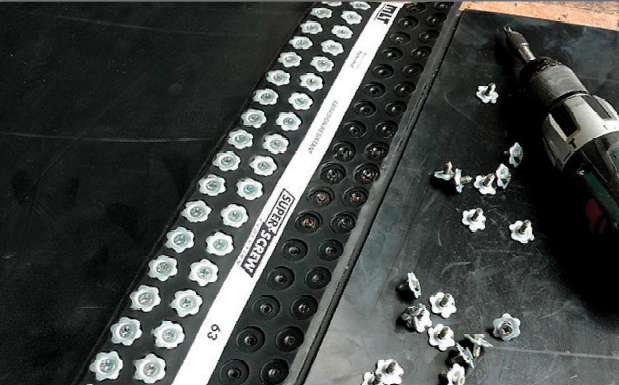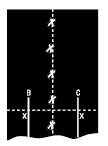Heavy Weight Conveyor Belting & Accessories
As an industry leader, we understand the critical role your conveyors play in your company’s productivity. That’s why RGA offers a variety of cover thicknesses and can customize belts to provide abrasion and impact resistance, oil and high temperatures. Our high quality products help take better care of your system.
- Rubber Belt
- Pvc Belt
- Bucket Elevator & Pocket Belt
- Belt Fasteners & Tools
- Elevator Buckets
- Splice/Belt Repair Kits

Conveyor Belt and Lacing
In addition to various grades and types of conveyor belting, we also handle a variety of lacing, and the complete Flexco™ line of lacing and belt wipers. Our experienced belt crew can install belting and lacing right on your conveyor. We also offer the more durable “Hot Vulcanized” splices for critical areas. Call us for a quote of your exact application.
Fastening Solutions that Last
SUPER-SCREW® Flexible Rubber Fastening System
The Choice Over Vulcanization
The simple and practical Super-Screw Flexible Rubber Fastening System can be used in place of vulcanization, saving you from long periods of downtime due to waiting for a crew to arrive, belt preparation, press set-up, and cooking time. It can also be used in the toughest, most demanding environments, regardless of climate and temperature, keeping your employees safer and more productive. It withstands temperatures from -22° F to 3928 F (-30° C to 200° C), making it the perfect alternative to vulcanization. This easy-to-install fastening system can be used to repair any spot on the belt, or for joining brand new belts ends, without the need for an outside service or skilled technician. The Super-Screw system is also compatible with belt cleaners, and smaller pulley diameters, and is highly abrasion resistant.


How It Works
The Super-Screw® Flexible Rubber Fastening System utilizes specially signed self-drilling, self-tapping screws that preserve the integrity the belt by passing between the carcass threads without cutting them. Super-Screw comes ready to be installed, with assembly pacers already in place, so that the top and bottom covers align correctly. Screws and Pozidrive or "PZ" bits are included for easy installation, without the need for tools beyond a standard powered drill or 1/4" impact driver. The result is a splice that can be installed anytime, anywhere, and in any weather condition.


FLEXCO® BOLT SOLID PLATE Fastening System
The Industry Standard for Strong, Long-Lasting Splices
Flexco® Bolt Solid Plate fasteners are engineered to meet the demands of the toughest material handling applications, providing a strong, sift-free splice with superior holding ability. A choice of sizes accommodates belts from 3/16” (5 mm) to over 15/16” (24 mm) thick.




High strength.
High strength is the result of superior design and plate compression on both the top and bottom sides of the belt. High tensile strength bolts compress top and bottom plates to distribute splice tension evenly across the entire width of each fastener plate. For added strength and pullout resistance, specially formed teeth penetrate deep into resistance the belt carcass – without damaging carcass fibers.
Easy installation.
Field-proven templets, punches, and boring tools make it easy to quickly and accurately prepare belts for fastener installation. Fasteners are easily installed on-site using portable hand tools or power tools. Our exclusive piloted bolts also contribute to faster installation.
How to Square a Belt Using The Centerline Method
Benefits of a Properly Squared Belt
Squaring your belt ends is a job that requires only a few minutes of your time, but offers real paybacks in extending your belt splice life. A splice that is applied on a properly squared belt will have tension evenly distributed across the splice and will track properly. Improper squaring of a belt can lead to belts mistracking and splices catching on conveyor components, causing early failure.


Step 1
Prior to any work on your conveyors make certain that the power has been turned off and the belt is *locked out* Follow other safety precautions outlined in the operator's manual.


Step 2
Mark the actual center points in belt width at intervals of 3 to 5 feet, for a distance back from the intended splice area of 15 to 20 feet.


Step 3
Using either a steel rule or a chalk line, mark the average center line through the points measured from Step 2.


Step 4
Using a square, draw a Line perpendicular to your average center line across the belt width.


Step 5
For even greater accuracy in preparing your squaring line, after completion of Step 3, mark two lines (B&C) equal distance from the center line in the area where you are going to install the splice. running parallel to the center line.


Step 6
Measure back from the intended splice area a distance equal to approximately three times the belt width and mark this point. Then measure equal distances to lines B & C at the intended splice area and mark these points.


Step 7
Align a steel rule through these points across full width of the belt. The resulting line is the true square.


Step 8
Mark this line and cut your belt at this line using the 900 Belt Cutter.
Note: Preparing belt ends for a 45° splice
1. Find and mark center line of both belt ends.
2. Square one belt end as described above.
3. Cut squared end on 45° angle.
4. Lay 45° cut end over uncut end making sure center lines match and are straight.
5. Use 45° cut as guide for cutting other belt end.





